HADDONFIELD DIG YIELDS 4,000-YEAR-OLD INDIAN ARTIFACT
Indian King Summer Archaeology Project Ends Richly

By Hoag Levins ...| ...July 21, 2005


HADDONFIELD, N.J. -- The crown jewel of six weekends of archaeological excavation at the Indian King Tavern Museum is a Native American broadspear -- or stone cutting tool -- dating to as early as 2000 BC, according to project manager Steven Hardegen.
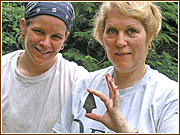
|
| Photo: Hoag Levins |
Holding the ancient Native American broadspear excavated from the Indian King Tavern Museum's back yard is archaeology student Cathy Holusha of Morristown, N.J. and team mate Courtney Barger of Pemberton. Although they look like arrowheads, broadspears were used as a kind of knife by early Indian tribes in the Delaware Valley.
Click for larger view.
|
3,5000 artifacts
Mr. Hardegen, a senior adjunct professor of archaeology at Burlington County Community College and senior historic preservation specialist with the New Jersey Office of Historic Preservation in Trenton, organized the dig that wrapped up on July 16th. The project recovered more than 3,500 individual artifacts from pits dug across the rear yard of the state historical site in downtown Haddonfield.
"We chose this site because there had not been any previous archaeology done here," said Mr. Hardegen. "The fact that this tavern had so many out buildings associated with it -- privies, wells, summer kitchens, barns, stables and distilleries spoke of its great potential for artifacts. In one of our (pits) we also found the post holes of a post-and-beam structure, providing us with our first hard information on those other buildings."
Ironically, Mr. Hardegen, who leads an annual summer dig as part of the college's "Field Methods in Archaeology" course, has spent the previous four summers excavating ancient Native American sites in Fort Dix. This year, the Haddonfield resident brought his class home to the Indian King Tavern, aiming for artifacts from the later European colonial period.
Hand-flaked implement
Discovery of the ancient Indian broadspear in perfect condition both surprised and energized everyone involved in the dig, he said. Made of jasper, a flint-like mineral quarried in areas of New Jersey and Pennsylvania north of New
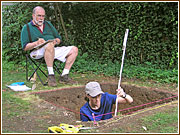
|
| Photo: Hoag Levins |
A stone's throw from the rear door of the tavern building Charlie Bradey of Moorestown, N.J., takes notes as Denise Papp of Browns Mills takes the latest measurements in one of the excavation pits. Click for larger view.
| Hope, broadspears were hand-flaked edged implements used as spear points or knives by early Delaware Valley tribes.
"This is a textbook example of what a Perkiomen broadspear looks like," said Mr. Hardegen. "Enough areas have been carbon dated to establish date ranges for this kind of thing and this particular one is about 4,000 years old."
The 292-year-old town of Haddonfield sits in an area that was a major crossroads of Indian travel and habitation at the time of the arrival of Europeans in the late 1600s. The very name of the Tavern -- The Indian King -- is a Colonial reference to the Indian "kings" or chiefs who ruled the tribes whose members interacted with Europeans. The overall regional presence of those native people stretches back thousands of years.
Back to 1740s
Beyond the ancient broadspear, Mr. Hardegen's crew of a dozen students and volunteers unearthed a vast array of artifacts from local Colonial life as far back as the 1740s.
Opened in 1750 as the town's premiere tavern containing the region's largest non-church public meeting room, the Indian King Tavern was a social and political gathering center throughout the period of the American Revolution.
Throughout the summer in the facility's back yard, inch-by-inch excavation with hand trowels has yielded thousands of pieces of hand-blown bottles, clay pipes, animal teeth and bones, hand-made nails and hinges, bits of tavern equipment, oyster and clam shells, earthenware, china and other kinds of ceramics.
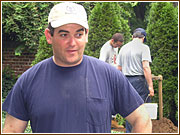
|
| Photo: Hoag Levins |
Steve Hardegen, a senior adjunct professor of archaeology at Burlington County Community College, led the archaeology project that stretched over six weekends at the Indian King Tavern site. He selects a different historic location every year for summer field work by his students. Click for larger view.
| Mr. Hardegen explained that the artifacts, which are officially the property of the State, will be cleaned, cataloged and studied at the college and then made available to the Indian King for display inside the museum.
'Cultural touchpoint'
Richard Pillatt, president of the Camden County Historical Society, who was on hand for the last day of the dig, noted, "Tavern life is such an important cultural touchpoint for interpreting local 18th-century history that anything that furthers our knowledge about it is very exciting."
"It's one thing to make educated guesses about the material cultural of Camden County in the 1700s and another to actually hold it in your hand fresh out of the ground," he said. "The finds made here by Mr. Hardegen's class will advance our knowledge of this key state historical site and should ultimately result in a local exhibit that makes the Indian King even more interesting and meaningful to the general public."
Museum manager Bill Mason
Bill Mason, the tavern museum's historic preservation specialist and manager, ushered visitors to and from the back yard work area throughout the day. One of his favorite objects to emerge from one of pits was a metal tap for tavern whiskey and beer kegs.
"The sheer amount of materials they've found in such a short time is amazing," he said. "The students are using two six-foot by six-foot tables to wash and dry all the excavated items they find and there were days during the last two months when both table tops were completely filled with dish fragments, cup fragments, blueware and pottery and other things."
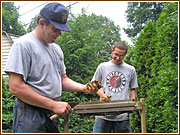
|
| Photo: Hoag Levins |
Manning one of the screen used to separate small artifacts from large amounts of dirt is Robert Kotlarek (left) of Medford and Ray York of Mount Laurel (right). Mr. Kotlarek, who was the field assistant helping to manage the project, also works for the State's Historic Preservation Office in Trenton. Click for larger view.
|
"Visitors have been fascinated," said Mr. Mason. "On their way out, most of them say it is the first time they have ever gotten to see an actual archaeology dig up close in real life -- and it has obviously made quite an impression on all of them."
Public impact
The fact that such visits can have a long-lasting effect was nowhere more obvious than in the presence of Ernie Troiano, a Cherry Hill resident who is semi-retired after a career in commercial archaeology. A volunteer assistant to Mr. Hardegen for the project, Mr. Troiano formerly performed excavations and historic artifact evaluations for a Northern New Jersey cultural resource management company.
And many decades ago his first interest in things historic was sparked when, as a 5th grader, he came to the Indian King Tavern on a class trip.
Throughout his years of assessing locations tentatively slated for development he has amassed samples of pottery shards from typical digs across the region. This "Type Collection" can be an invaluable help at archaeological digs because it provides an instant visual comparison reference for most of the pottery and ceramics shards coming out of the ground.
Tool for identifying artifacts
"I was a cataloger and whatever came out of the ground, I had to identify," he explained. "The collection became a very handy tool. I also used it to train others in the company who were just starting and were able to use such a wide range of documented hands-on samples to quickly identify artifacts. For the same reasons, it has proven very popular and effective with not only the students doing this dig but a lot of the visitors who have been coming through who are interested in the specifics of historic ceramics."
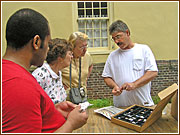
|
| Photo: Hoag Levins |
Ernie Troiano of Cherry Hill (white shirt), who worked for many years with a cultural resource management company, was on hand throughout the dig to explain the typical kinds of pottery, ceramics and glass found at regional historic sites. Click for larger view.
|
Unlike other observers who were amazed at the large number of materials taken out of the ground during the Indian King dig, Mr. Troiano said he was not.
"Colonial tavern sites were places of such intense human activities and traffic in physical goods they tend to accumulate a lot of material underground," he said. "Others sites I know of produced as many as 20,000 artifacts from a similar dig. But each case is different. For instance, here at the Indian King the dig is close in to the main building. But the actual property lines in the 18th century went back a couple of blocks. There were a lot of out buildings and activities that produce the highest level of archaeological artifacts were probably taking place further away from the main building and well beyond the current property line. There's no doubt a lot of stuff out there a block away."
Haddonfield underground
"To give you an example, I left the Indian King last Saturday and went to my car parked down the street where a renovation was going on. They had dug a pit around the side of the building because they were redoing some part of the basement. As I was walking by, I could see the dirt mound was filled with artifacts from all different periods. Some of the artifacts were obviously very early. But that's what makes Haddonfield such an underground treasure house. You've had centuries of residents dumping their stuff everywhere and now we all walk on top of it every day without thinking it about it."
| 










